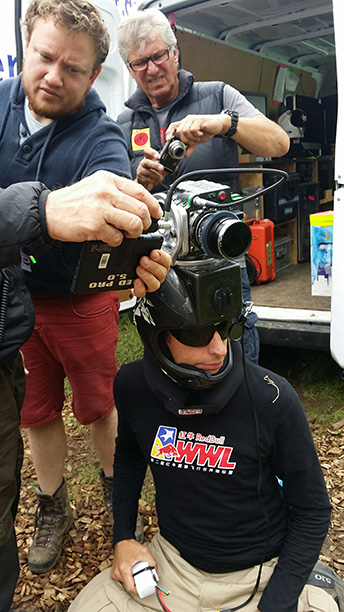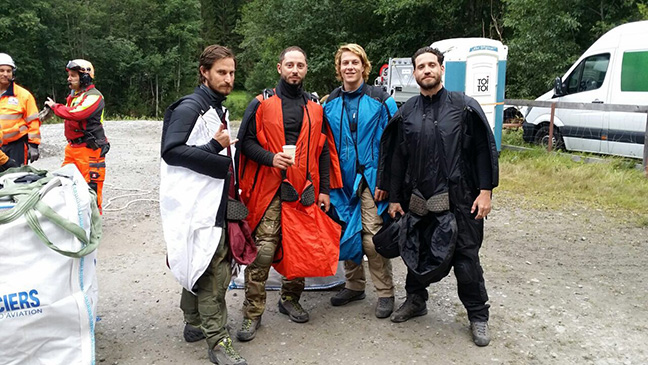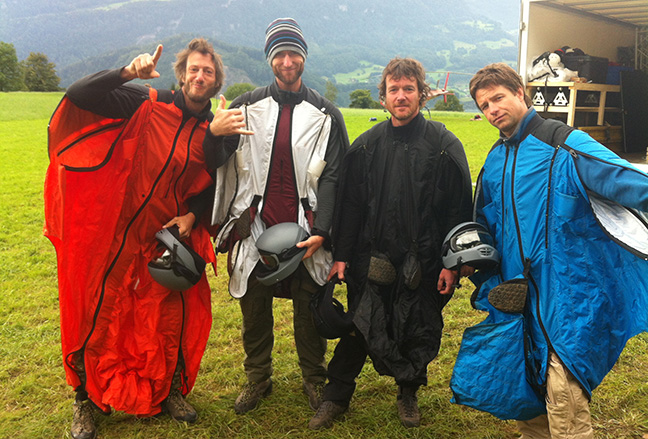Tales from the Bonfire | The Big Screen
Above: James Boole (left) and Jhonny Florez.
The helicopter turbine roared to life, snapping me back to reality. It was really happening! I was filming for a Hollywood movie. On top of that, I was helping to remake one of the films that inspired me to start skydiving in the first place: “Point Break.” After 10 years of filming wingsuit flying for TV shows, commercials and documentaries, I was finally realizing my dream of shooting a true feature film.
There had been some disappointments along the way. In 2008 I was “baby decorating” when stunt coordinator Tim Rigby called. He was putting together a team for “Point Break 2,” with the main action sequence being a wingsuit formation over the beach paradise of Bali. It would then transition to an extreme-terrain flight with the protagonists landing their parachutes inside the world’s largest sinkhole (in China). Inside they would find Bodhi, still hiding from the FBI, and Patrick Swayze was on board too! It was all-go, gear ordered, dates set and flights booked … until it wasn’t. Millions of dollars transferred to Bali for pre-production had vanished, embezzled by corrupt officials, and the whole project was canceled.
 The 11-pound camera setup
The 11-pound camera setupIn 2011, the phone rang again. It was a well-spoken lady who worked for Ridley Scott, who wanted me to shoot a wingsuit BASE jump for his film “Prometheus.” Again: Suits and helmets purchased and dates set, only for Scott to change his mind due to too many other movies featuring wingsuits.
Now here I was, onboard a helicopter in Switzerland, with the best wingsuit pilots in the world ready to go. The sequence would involve a 4-way wingsuit BASE jump, formation flying through the legendary Crack. Noah Bahnson, Julian Boulle, Jon Devore and Mike Swanson were the formation flyers—Floridian wingsuit legend Jeff Nebelkopf was originally supposed to be there, but he was sadly killed in a skydiving accident before production began.
I had spent many rainy days at the drop zone as a newbie skydiver watching Jon and Mike’s work in the legendary “Chronicles” freefly films, so I felt a little starstruck sharing the sky with them. I also admired Julian and Noah, who together with Mike had been flying full-time in Dubai, helping to redefine the sport. During training, I’d been blown away how they flew together as one piece; In the time it took me to take a step and follow them out the door, they would already be in tight formation.
Normally, wingsuit BASE jumps through the narrow Crack gorge in Walenstadt are solo, or maybe as a pair. A four-way formation (plus camera) was unheard of, due to the skill required and extra risk of collision or burbling each other at the wrong moment. To mitigate risks, the team had done two training camps—one skydiving in California and the second BASE jumping on the film site just before production started. By the way, the whole reason the wingsuit sequence was included in the movie was because the director, Ericson Core, had seen Jeb Corliss’s YouTube video “Grinding the Crack.” Jeb was recovering from an injury at the time but still worked as a coordinator and made a cameo in the film.
Jhonny Florez, who was also working with the cameras, and I had been working to physically prepare ourselves to jump with the RED Epic cinema cameras mounted on our helmets. Together with lens, mount and helmet, the setup was around 11 pounds. We both wore neck scarfs throughout production accompanied by the faint smell of Tiger Balm. It was the most expensive hat I have ever worn.
Finally, the helicopter lifted off and a few minutes later, we were hovering next to the exit point. We stepped off the skid onto the peak of Chässerugg mountain, prepared for the jump, made sure cameras were rolling and then 3-2-1, See Ya!
The first jumps were difficult. I was feeling the pressure to get the shot and was also concerned about injuring my neck. As a result, I was very tense and flared my wingsuit too much, which caused bad body position and gave me terrible line twists on the first half-dozen jumps or so. I started to relax after that, getting more comfortable with the weight of the camera, and my openings improved. I also was set up with a radio system that I could use to request speed changes from the base flyer. Being behind and handicapped by the camera, I would usually ask him to wait for me to catch up before we approached the Crack.
In the production unit’s tent village next to the landing area, there was a large notice board with the storyboards for the film. They wanted 133 shots in total. Sometimes we could get a few on a single jump, sometimes only one. Rarely none. But this was by far the longest, most complicated and dangerous BASE jumping sequence attempted to date.

Four actors (Clemens Schick, Matias Varela, Luke Bracey and Edgar Ramirez) ...

… and their four respective wingsuit pilots.
Some of the shots had never been done, and Jon had invented new mounts to get certain angles. For some jumps, the camera flyer was the base with the camera pointing backward—which means that the formation flyers would have to fly themselves into frame (without looking at the camera). Some of those looked so good that people thought it was fake. Another shot required me to jump with the camera on a belly mount. It was like driving with the handbrake down!
There was one serious close call during the shoot. One particular shot required the formation to fly low over the meadow with the flyers passing either side of a high-speed camera that was set up on the ground at the entrance of the Crack. On one attempt, a flyer went low and found himself underneath the formation. Popping back up into position could have caused a dangerous collision, so he decided to stay there, and the result was one of the closest ground fly-bys ever caught on film, with blades of grass bouncing off his helmet visor. No further attempts were made at this shot, but you can guess which version they used in the film!
In total, the crew consisted of 75 people and two helicopters. They all definitely thought we were crazy at first, but warmed up to us once they saw the footage we were getting and how well-disciplined we were. Over 60 BASE jumps went into the sequence, with Jhonny and I taking turns wearing that heavy camera on our heads. But as the project progressed, we got stronger: One particular day, I called time after seven jumps, Jhonny took over for another seven, and then the formation made another three without us. We were on fire. The shoot took just over a month to complete, but that was mostly due to fighting bad weather. The final week, we moved locations to Lauterbrunnen to shoot the exit from Jungfrau, which looked more dramatic than where we exited above the Crack.
We said our goodbyes, went our separate ways and returned home tired but happy. We’d gotten 130 of those 133 shots, and we were satisfied (and relieved) with the footage we had captured. Dreams realized, memories made.
Fast forward to the present: I was jumping at my local drop zone recently, and I was approached by a young Italian skydiver. He asked me, “Are you the guy that was part of the wingsuit flying in ‘Point Break?’” I answered with a yes.
“I saw that movie 10 years ago when I was 13, and it inspired me to become a skydiver!”
James Boole | USPA #165544
Nago, Italy